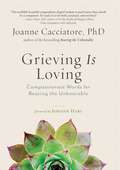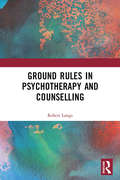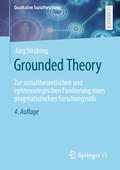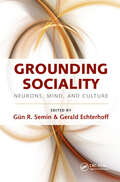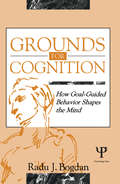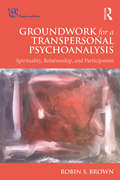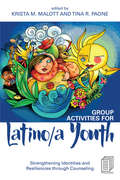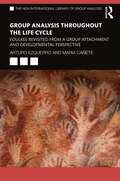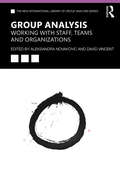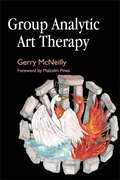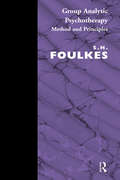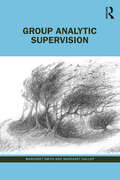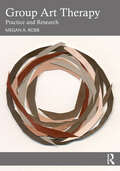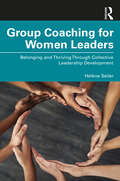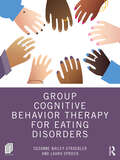- Table View
- List View
Grieving is Loving: Compassionate Words For Bearing The Unbearable
by Joanne CacciatoreIn the style of a quote-a-day collection, this book from Wisdom&’s bestselling author Joanne Cacciatore distills down the award-winning book Bearing the Unbearable into easy-to-access small chunks, and includes much brand-new material, including new prose and poems from Dr. Jo and other sources as well.From INDIES Gold Medal Award-Winner and Wisdom Bestseller Joanne Cacciatore If you love, you will grieve—and nothing is more mysteriously central to becoming fully human. This book is a companion to carry with you throughout your day, to touch in with and be supported by when bearing the unbearable pain of a loved one&’s death—whether weeks or years since their passing. Our culture often makes the bereaved feel alone, isolated, broken, and like they should just &“get over it&”—this book offers a loving antidote. Open to any page and you&’ll find something that will instantly help you feel not alone, while honoring the full weight of loss. This book is comprised of quotations from Bearing the Unbearable, and other sources as well, plus an enormous amount of new material from Dr. Jo. Especially well-suited for the grieving mind that may struggle with concentration, just 30 seconds on any page will empower, hearten, and validate any bereaved person—helping give strength and courage to bear life&’s most painful losses. Praise for Bearing the Unbearable &“This masterpiece is the greatest gift I could give to someone entrenched in grief, or to the loved ones of the bereaved.&”—The Tattooed Buddha &“Simply the best book I have ever read on the process of grief.&”—Huffington Post &“Anyone who's trying to deal with a loss, or anyone who knows someone dealing with a loss, (and in truth, isn't that everyone?) will benefit from reading this amazing book.&”—Foreword Reviews &“It offers hope for those who feel like their loss has disconnected themselves forever from humanity and the circle of life.&”—Doug Bremner, MD, professor of psychiatry, Emory University and author of You Can&’t Just Snap Out of It &“This is a holy book, riddled with insight and compassion.&”—Francis Weller, author of The Wild Edge of Sorrow
Grit in the Classroom: Building Perseverance for Excellence in Today's Students
by Laila SangurasThe combination of sustained hard work and resiliency, grit is the difference between those who give up and those who don't. Grit in the Classroom: Building Perseverance for Excellence in Today's Students assists educators in creating a learning environment that fosters grit development for all students, regardless of ability. Each chapter includes stories to illustrate the research and ideas presented and ends with discussion questions that can be used to continue the conversation. In an era of talent development and the pursuit of excellence, learners must be equipped with the perseverance that is essential to reaching high levels of success. This book provides a rationale for teaching grit in the classroom with the goal of propelling this topic into discussions of building passion and talent in today's students.
Ground Rules in Psychotherapy and Counselling
by Robert LangsRobert Langs has long been one of the most individual and controversial psychoanalytic theorists. In this book, he concentrates on one of the most prominent areas of his thought: his insistence upon adherence to strict rules for boundaries (or "frames") in psychotherapy and psychoanalysis.Starting from the statement that "Throughout the history of the universe, frames, contexts, rules, and boundaries have been vital aspects of the development and very existence of both physical structures and living organisms," Langs goes on to examine the profile of the issues of boundaries in psychoanalytic thought. He discusses Freud's technique papers on the subject, and goes on to elucidate his own approach, rooted in his thinking on evolutionary and adaptive processes which he has discussed in his previous work. Throughout the book, Langs gives both theoretical discussions and practical groundings of his ideas. As with his previous book, Doing Supervision and Being Supervised (1994), Robert Langs here brings his unique energy and viewpoint to bear on an important but little-examined topic.
Grounded Theory: Zur sozialtheoretischen und epistemologischen Fundierung eines pragmatistischen Forschungsstils (Qualitative Sozialforschung)
by Jörg StrübingWenig wurde bislang über die erkenntnistheoretische Fundierung der Grounded Theory in der pragmatischen Sozialphilosophie und die daraus resultierenden Konsequenzen für das Verständnis der methodologischen Konzeption wie der praktischen Verfahren geschrieben. Der Band schließt diese Lücke, indem das Erkenntnismodell, ausgehend von den Arbeiten von C.S. Peirce, J. Dewey, G.H. Mead und W. James, vorgestellt und den Spuren nachgegangen wird, die dieses Modell als Geltungsbegründung in der Methodologie der Grounded Theory hinterlassen hat. Dabei geht der Text auch auf die gravierenden methodologischen Unterschiede zwischen der von Anselm L. Strauss geprägten und der von Barney G. Glaser vertretenen Variante von Grounded Theory ein und beschäftigt sich mit wesentlichen Weiterentwicklungen einer pragmatistischen Grounded Theory im Kontext postmodernen Denkens. Die vorliegende, vierte Auflage schließt zudem den aktuellen Diskurs um die Etablierung ansatzübergreifender Gütekriterien qualitativen Forschens an die Grounded Theory-immanenten Strategien zur Qualitätssicherung an. Forschende erhalten damit eine wertvolle Argumentationshilfe für die Legitimation ihrer empirischen Designs.
Grounding Sociality: Neurons, Mind, and Culture
by Gün R. SeminThis volume concerns the longstanding intellectual puzzle of how individuals overcome their biological, neural, and mental finitude to achieve sociality. It explores how humans take each other into account, coordinate their actions, and are able to share their inner states and to communicate. Sophisticated views on the bases of sociality are detailed at the level of neural mechanisms, perception and memory, motivation, communication and dialog, culture, and evolution. These insights have been inspired by major strides and exciting new developments in disciplines as far afield as ethology, evolutionary ecology, neuroscience, cognition, memory, developmental and social psychology, psycholinguistics, philosophy, robotics, and sociology. The volume is the first to bridge these disciplinary boundaries to lay the foundations for an integrated and general conceptualization of the bases of sociality and its implications for psychology. Each contribution presents different levels of the grounding of sociality and will further stimulate novel approaches to linking different layers of sociality, from the neural to the cultural level.
Grounding for the Metaphysics of Morals: with, On a Supposed Right to Lie Because of Philanthropic Concerns
by Immanuel Kant James W. EllingtonTranslation of: Grundlegung zur Metaphysik der Sitten: and of: Uber ein vermeintes Recht aus Menschenliebe zu lugen. This is the third edition of this volume.
Grounding the Analysis of Cognitive Processes in Music Performance: Distributed Cognition in Musical Activity (Explorations in Cognitive Psychology)
by Linda T. KaastraThrough the systematic analysis of data from music rehearsals, lessons, and performances, this book develops a new conceptual framework for studying cognitive processes in musical activity. Grounding the Analysis of Cognitive Processes in Music Performance draws uniquely on dominant paradigms from the fields of cognitive science, ethnography, anthropology, psychology, and psycholinguistics to develop an ecologically valid framework for the analysis of cognitive processes during musical activity. By presenting a close analysis of activities including instrumental performance on the bassoon, lessons on the guitar, and a group rehearsal, chapters provide new insights into the person/instrument system, the musician’s use of informational resources, and the organization of perceptual experience during musical performance. Engaging in musical activity is shown to be a highly dynamic and collaborative process invoking tacit knowledge and coordination as musicians identify targets of focal awareness for themselves, their colleagues, and their students. Written by a cognitive scientist and classically trained bassoonist, this specialist text builds on two decades of music performance research; and will be of interest to researchers, academics, and postgraduate students in the fields of cognitive psychology and music psychology, as well as musicology, ethnomusicology, music theory, and performance science. Linda T. Kaastra has taught courses in cognitive science, music, and discourse studies at the University of British Columbia (UBC) and Simon Fraser University. She earned a PhD from UBC’s Individual Interdisciplinary Graduate Studies Program.
Grounds for Cognition: How Goal-guided Behavior Shapes the Mind
by Radu J. BogdanQ: Why do organisms need cognition? A: To get information about their environments. Q: Why such information? A: Because organisms need to guide their behaviors to goals. Q: Why guidance? A: Because it leads to goal satisfaction. Q: Why goals? Cognition is a naturally selected response by genetic programs to the evolutionary pressure of guiding behaviors to goals. Organisms are material systems that maintain and replicate themselves by engaging their world in goal-directed ways. This is how guidance of behavior to goal grounds and explains cognition and the main forms in which it manages information. Guidance to goal also makes a difference to the understanding of human cognition. Simpler forms of cognition evolve to handle fixed informational transactions with the world, whereas human cognition evolves the abilities to script flexible goal situations that fit specific contexts of behavior. This teleoevolutionary approach has important implications for cognitive science, two of which are programmatic. One is that information that guides to goal is not exclusively cognitive; guidance is also affected by ecological facts and regularities as well as by design assumptions about them. The other implication is that the functional analyses dominant in cognitive science and philosophy of mind are incomplete and weak. They are incomplete in that they focus only on the explicitly encoded cognitive information and its behavioral consequences, thus ignoring the larger guidance arrangements; and weak because causal and functional relations implement but underdetermine goal-directed and goal-guided procesess. A work dealing expressly with the foundations of cognitive science, this book addresses basic but seldom-asked questions about the evolutionary rationale of cognition and the way this rationale has shaped the major types of cognition. It also provides a teleological answer to these basic questions in terms of goal directedness and particularly guidance of behavior to goal. In so doing, the work defends the scientific respectability and the explanatory necessity of teleology by showing that goal directedness characterizes the work of genetic programs.
Groundwork for a Transpersonal Psychoanalysis: Spirituality, Relationship, and Participation (Psyche and Soul)
by Robin S. BrownThis book explores how a deeper engagement with the theme of spirituality can challenge and stimulate contemporary psychoanalytic discourse. Bringing relational psychoanalysis into conversation with Jungian and transpersonal debates, the text demonstrates the importance of questioning an implicit reliance on secular norms in the field. With reference to recognition theory and shifting conceptions of enactment, Brown shows that the continued evolution of relational thinking necessitates an embrace of the transpersonal and a move away from the secular viewpoint in analytic theory and practice. With an outlook at the intersection of intrapsychic and intersubjective perspectives, Groundwork for a Transpersonal Psychoanalysis will be a valuable resource to analysts looking to incorporate a more pluralistic approach to clinical work.
Group Activities for Latino/a Youth: Strengthening Identities and Resiliencies through Counseling
by Krista M. Malott Tina R. PaoneDirectly applicable to practice, Group Activities for Latino/a Youth allows helping professionals such as human service workers, social workers, and school and community mental health counselors to select and apply a series of group sessions with topics relevant to today’s Latino/a youth. Each session contains detailed directions, suggested discussion questions, and additional readings on specific topics, with topic examples including grief, identity development, and conflict resolution. Sessions draw on Latino/a cultural norms and strengths to build culturally-informed communication and coping skills in an effort to improve educational, social, and career outcomes. A developmental perspective is used, and sessions are designed to be creative and interactive in order to appeal to the high energy and playfulness of youth at any age. Group Activities for Latino/a Youth helps professionals to better engage and retain Latino/a clients, a group that traditionally experiences one of the largest drop-out rates in therapy, often due to interventions largely informed by dominant Anglo norms and traditions.
Group Activities for Social Emotional Learning using Sketch Comedy and Improv Games
by Shawn Amador Eleni LiossisChildren with strong social-emotional skills are better able to cope with everyday challenges and benefit academically, professionally, and socially. But the benefits that can be derived from these skills can only be seen if children are given the opportunity to develop them.This accessible guide helps teach children to participate in social-emotional learning. Offering fun group activities including social skill-based improv games, participant written plays, and basic plays that can be transformed using the creative minds of children themselves. To increase participant comfort levels with these activities, the book allows for a graduated exposure of techniques, starting with improv trust building and joint focus games, and progressing to improvisation and writing sketches.Featuring additional downloadable content, including worksheets and lesson plans for classroom use, this is the perfect companion for educators and therapists.
Group Analysis for Refugees Experiencing Trauma
by Aida AlayarianIn this prescient and sensitive volume, Aida Alayarian looks at how psychoanalysis in group settings can benefit refugees who have experienced trauma, with an express focus on transference and countertransference. Group Analysis for Refugees Experiencing Trauma offers a comprehensive overview of trauma from a psychoanalytic perspective, before delving into the nuance of trauma experienced by asylum seekers, refugees and those who have gone through forced migration. Through clinical vignettes, Alayarian highlights the importance of the resilience that can be brought about from group sessions and shared experience in helping to heal the wounds of trauma. She looks at the vital role of social injustice in this trauma and shows how this can be directly applied to work with other groups experiencing human rights violations, destitution, and loss. She shows how looking at relational patterns as a means of understanding conscious, unconscious, and subconscious thought processes can provide essential breakthroughs with patients, as well as the importance of paying close attention to countertransference to avoid a breakdown of the clinical relationship. Using psychoanalytic theories from intercultural perspectives to show the multidimensional nature of work with trauma patients, this book is essential reading for psychoanalysts, psychologists, psychiatrists, and other mental health experts working with refugees and patients experiencing trauma.
Group Analysis in the Land of Milk and Honey (The New International Library of Group Analysis)
by Yael DoronGroup Analysis in the Land of Milk and Honey is a collection of beautifully written clinical essays by group analysts in Israel - a society which suffers from chronic war and violence. Israeli group conductors share their experience and their special skills concerning the reflection of terror and existential anxiety in their group-analytic therapy groups. The topics range from the influence of society on the individual, the nature of the "group", combined individual and group therapy, groups with mentally ill and elderly patients, and coping with aggressive patients and the self-destructive processes that are ubiquitous in a society threatened with extinction. These group analysts discuss breaking of boundaries, "democracy in action", leadership, paternalism and fanatic identifications. The special place of Shoah survivors and of Arab and Jewish conflict make this book unique. The book conveys both the trauma and the creativity of Israeli society. The editors, Dr Robi Friedman and Yael Doron, represent different generations within the IIGA - the Israeli Institute of Group Analysis.
Group Analysis throughout the Life Cycle: Foulkes Revisited from a Group Attachment and Developmental Perspective (The New International Library of Group Analysis)
by Arturo Ezquerro María CañeteArturo Ezquerro and María Cañete present a captivating journey through human development, group lives and group attachment from infancy all the way into old age. Co-constructed with meticulous anthropological, psychosocial, cultural and clinical research, as well as true, stirring stories and insights which contain a rare blend of common sense and inspiration, this book offers an exciting new outlook on attachment and group analysis. Group Analysis throughout the Life Cycle first assesses psychosocial, peer group and other group developmental studies, within a broad evolutionary and cultural context, looking into changes and constancies, continuities and discontinuities, as well as overlaps that occur throughout each developmental stage. It then presents a thorough review of psychoanalytic, group-analytic and wider group literature. The book concludes with a consideration of qualitative group-analytic research which examines clinical group phenomena that can be present in all age groups, as well as distinct phase-specific characteristics and developmental tasks, as they find expression in the therapeutic process. Presented with frankness, self-reflective thinking and compassion, Group Analysis throughout the Life Cycle will be essential reading for psychotherapists, psychoanalysts, group analysts, psychiatrists and other professionals in practice and in training. It will also appeal to healthcare professionals interested in human development and attachment theory.
Group Analysis: A Modern Synthesis (ISSN)
by Sigmund KarterudGroup Analysis outlines how clinical group analysis can re-establish itself as a leading paradigm for group psychotherapy.Sigmund Karterud explains how the focus of group analysis and its applications can be expanded by stronger emphasis on the philosophy and psychology of the self. The book is divided into four parts, with part one reconsidering the historical roots of group analysis through its founder S. H. Foulkes and part two demonstrating how the fields of evolution, primary emotions, attachment, mentalizing, personality theory and personality disorders can be integrated with group analysis. Part three develops a philosophy of the self that includes a group self which accounts for the we-ness of groups, and part four illustrates how these concepts can inform the practice of group analysis through a series of clinical vignettes addressing the major challenges which face the clinician.Group Analysis: A Modern Synthesis will be essential reading for all group psychotherapists in practice and in training. It will also appeal to students of group analytic psychotherapy.
Group Analysis: Working With Staff Teams And Organizations (The New International Library of Group Analysis)
by David Vincent Aleksandra NovakovicFeaturing contributions from a range of organizational contexts, Group Analysis: Working with Staff, Teams and Organizations identifies the key features to group analytic practice as well as how different theoretical orientations, such as Systemic and Tavistock Consultancy approaches, can be incorporated into the process. The book addresses two essential features of group analysis: the exploration of unconscious dynamics in groups, and the shifts of observational attention between the group as a whole, the individual in the group, and the group in the individual. Including perspectives from both organizational consultancy and reflective practice, chapters feature analysis with groups and subgroups in a range of settings, including a forensic psychiatric hospital, a children’s hospice, an Anglican religious community and the management team of a global organization. Group Analysis: Working with Staff, Teams and Organizations is a major contribution to the developing literature on group analysis. It will be of great interest to psychotherapists, organizational consultants, facilitators of reflective practice groups, coaches, trainees in these disciplines, and any professionals who work with staff, teams, and organizations.
Group Analytic Art Therapy
by Gerry McneillyGroup Analytic Art Therapy, written by an internationally renowned psychotherapist, provides readers with a practical and theoretical framework for using group art therapy in a range of settings. Based on over 20 years' experience of conducting group art therapy, this book is packed with suggestions for group art therapy practice and many explanatory diagrams. The author also explores the dynamics and psychological effects of diverse group situations, based on examples from his own clinical practice, and offers an illuminating insight in to his own theories and practical applications of group art therapy in the context of the developments in the field. Group Analytic Art Therapy is both a comprehensive reference and an inspiring text for practising and trainee art therapists, psychotherapists and group therapists.
Group Analytic Psychotherapy: Method and Principles
by S.H. FoulkesThis book captures the flavor and spirit of the highly trained and experienced practitioner as he goes about the task of organizing and conducting a group. It also captures the warmth and humanity of a professional who is deeply devoted to his patients, his profession and humanity at large.
Group Analytic Psychotherapy: Working with affective, anxiety and personality disorders
by Steinar LorentzenGroup analytic theory is internationally recognised as an effective treatment for people suffering from mental distress, struggles with personal development and interpersonal problems. Integrating psychoanalytic and social psychological thinking and providing a group setting for self-discovery and developing social skills, long- and short-term courses in this type of therapy are increasing in popularity. This manual provides a detailed description of both long- and short-term versions of group analytic therapy, with rich and vivid clinical examples to illustrate theory and techniques. Group Analytic Psychotherapy describes in detail what a participant may expect, differences between short- and long-term therapy and how to behave as a group member, as well as the main issues the clinician has to deal with. Topics covered include: Group Analytic Theory Methodology Clinical Examples Therapist Adherence and Competence Providing a basis for understanding the dynamics of groups at work in offering emotional support and a positive atmosphere, Group Analytic Psychotherapy is ideal for clinicians, students and informed patients as well as all psychodynamically oriented professionals in the field. It is an essential manual for those looking to learn the main attributes of short-term intervention.
Group Analytic Supervision
by Margaret Smith Margaret GallopGroup Analytic Supervision uses group analytic concepts to cast light on how group supervision works, covering history, theory and practice. Margaret Gallop and Margaret Smith illustrate the benefits that supervision can provide for post-qualification group supervision. This book offers a model of group analytic supervision, the clinical hexagon, to support supervisors of groups in thinking about their supervision group and its process. Gallop and Smith use vignettes to illustrate how supervision groups work together to broaden and deepen their understanding of their clients, including examples that demonstrate the benefits of this multi-perspective approach for therapists providing dyadic therapy. Group Analytic Supervision addresses several of the key tasks for supervisors of groups, including establishing and maintaining boundaries around the work, establishing good working relationships, working with parallel process, transference and countertransference. It describes using difference and diversity to enrich learning and it stresses the importance of self-care. Group Analytic Supervision will be essential reading for anyone who is providing group supervision, particularly therapists who undertake group analytic training. It will also be of great interest to counsellors and therapists, social workers, probation officers and healthcare staff who both provide and receive group supervision.
Group Analytic Therapists at Work: Everyday Group Analysis
by David Vincent Amélie NoackGroup Analytic Therapists at Work is an accessible introduction to the experience of being in group analytic psychotherapy from a wide range of perspectives. Written by members of the Group Analytic Network London, the chapters explore the history of group analysis and span key areas, including the political and the social, diversity and difference, gender and norms, and isolation and the social sphere. Group Analytic Therapists at Work contains discussion of themes such as group work with differing age ranges and life stages, cultural considerations, normativity, inclusion and exclusion, isolation and the internet. Each chapter provides insight from an experienced group analyst into what happens in groups, what group analysts think about while running their groups and, fundamentally, what group analysis is about. This book will be of great interest to psychotherapists in practice and in training, group therapists and group analysts and other professionals, as well as anyone else seeking to increase their understanding of group work.
Group Art Therapy: Practice and Research
by Megan A. RobbGroup Art Therapy: Practice and Research is the first textbook of its kind, taking into account practice-based evidence and using a transtheoretical approach to present a range of art therapy group interventions. The book covers essential topics including leadership, art making, successful therapeutic factors, and the basic stages of developing and facilitating groups. Offering practical information not only to students but also to experienced practitioners, the chapters provide details about preparation and practice, note-taking and documentation, and research tips. Adhering to the most up-to-date educational standards and ethical codes of art therapy, the book covers the full range of settings and art therapy approaches. This text will prepare art therapy graduate students and practitioners to lead groups in a variety of settings, theoretical approaches, and applications.
Group Coaching for Women Leaders: Belonging and Thriving Through Collective Leadership Development
by Hélène SeilerThis book is an invaluable resource for those looking to lead high-functioning women groups, and a testament to the power of group coaching for women leaders.Dr. Hélène Seiler advocates for the expansion of group coaching to support the fulfilment of women leaders, providing a comprehensive review of the relevant academic literature on group coaching for women leaders and an in-depth analysis of her reflective notes over the last 15 years. This book shares the author’s experience as an international group coach and an executive coach for women leaders, and echoes the voices of her former group members. Using case studies and practical tips, the author offers recommendations when forming a new collective of women leaders, shares best practices in high-functioning groups, provides solutions when dealing with breakdowns within a group, and provides guidelines to lead change when a group composition evolves. This book also addresses the potential impact of technology and artificial intelligence on the stakeholders of group coaching. Each chapter contains key points, multi-cultural case studies, and ends with reflective questions to enrich and personalize the reader’s learning experience.Group Coaching for Women Leaders is an essential resource for group coaches working with women leaders internationally, for academic leaders looking to extend their offerings for student coaches, and for corporate sponsors interested in augmenting the power of women leadership development initiatives in their organizations.
Group Cognitive Behavior Therapy for Eating Disorders
by Suzanne Bailey-Straebler Laura SprochThis treatment guide equips therapists with the necessary tools to implement the leading recommended treatment for eating disorders, "enhanced" cognitive behavior therapy (CBT-E), in a group format.Group CBT-E is a structured treatment designed to help patients make critical changes to their eating, dieting, and other eating disorder symptoms. It aims to engage patients in identifying and addressing over-evaluation of shape and weight, managing stressful events and emotions without eating disorder behaviors, and developing relapse prevention skills. The treatment guide includes detailed session agendas and outlines, practical tips, advice on addressing sensitive topics, and numerous reproducible handouts that patients can personalize for their treatment needs. Group CBT-E empowers patients to actively engage in their recovery journey and emphasizes the valuable support found in group therapy settings, where shared experiences foster learning, encouragement, and a sense of understanding. The treatment’s structured and individualized approach not only enhances patient outcomes, but also boosts therapist confidence.This book is a vital resource for therapists seeking clear guidance on implementing CBT-E in group format. Its practical components, such as clinical examples, therapist insights, patient handouts, and detailed CBT-E formulation guidance, are useful for all CBT-E therapists.
Group Cognitive Therapy for Addictions
by Bruce S. Liese Amy WenzelThis pragmatic guide from a team of experts including cognitive therapy originator Aaron T. Beck describes how to implement proven cognitive and behavioral addiction treatment strategies in a group format. It provides a flexible framework for conducting ongoing therapy groups that are open to clients with any addictive behavior problem, at any stage of recovery. Practical ideas are presented for optimizing group processes and helping clients build essential skills for coping and relapse prevention. Grounded in decades of research, the book features rich case examples and reproducible clinical tools that can be downloaded and printed in a convenient 8 1/2" x 11" size.
